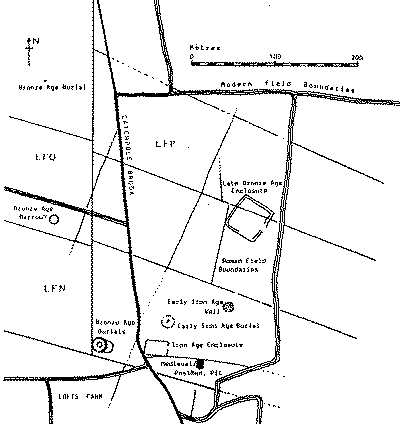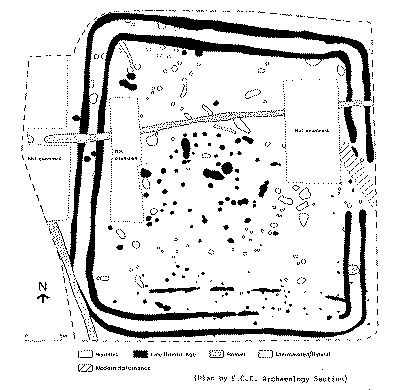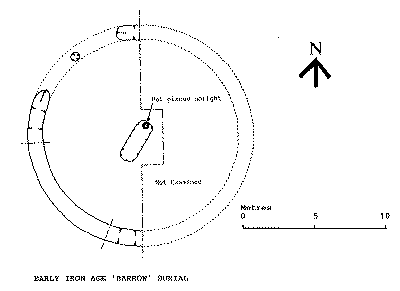|
|
LOFTS FARM PROJECT - INTERIM 1984-85The Project's original objective, to approximately date all the cropmark elements, was realised in October 1984, when excavation work started on the feint outline of a double-ditched enclosure in field LFP. Pottery indicated a Late Bronze Age date and fortunately, as with many other features recorded over the years, much more than basic dating evidence has been rescued. New discoveries have again come to light during close observation of topsoil stripping and gravel quarrying. Most of these were made in field LFP to the south of the Late Bronze Age settlement and include an Early Iron Age Well, an Early Iron Age 'Barrow Burial', a sub-rectangular Iron Age enclosure and a Medieval or Post-Medieval pit. THE LATE BRONZE AGE ENCLOSURERecognising the potential of the site, Maldon Archaeological Group sought assistance from the Essex County Council Archaeology Section. With the aid of a grant from the Historic Buildings and Monuments Commission and with co-operation of Contractors Aggregates, the ECC Section continued the excavation through harsh winter months in conjunction with MAG. The enclosure was double-ditched with a single, east facing entrance. The ditches were irregular and very slight, often only 30 or 40 cm (1ft or 1ft 4in) deep and less than 1m (3ft 3in) wide. Only on the north side were they more substantial, being over 50cm (1 f t 7 in) deep and up to 1 .5m (4f t 11 in) wide. Near the south-east corner there was no trace of the inner ditch for a length of approximately 12m (39ft). However, numerous post holes in the area may represent a fence-line or simple structures blocking the gap. If the narrow gap between the ditches had been occupied by spoil and capped- by a hedge or fence, an effective barrier would have been provided, preventing animals from getting in or out of the enclosure. The ditches may also have been for drainage. Situated just to the west of the centre of the enclosure were the postholes of a single sub-circular building, about 10m (33ft) in diameter, with traces of a porch to the south-east. This building contained a number of internal pits and post holes and was surrounded, particularly on its south and west sides, by a scatter of similar pits and post holes. Some may have been storage pits and it is possible -to discern at least two four-post structures, probably also for storage. There seem to be traces of a fence-line separating the central building from the northern part of the enclosure. This, fence may have continued a line of post holes which divided the 8m (26ft 3in) wide enclosure entrance, and may have been designed to channel livestock into the northern part of the enclosure, an area with relatively few features. Finds consisted mainly of pottery with smaller amounts of flint work and fired clay objects, including a spindle-whorl and a number of fragments of perforated clay slabs. These distinctive slabs are characteristic of Late Bronze Age sites in the Thames valley and are known from sites in the Chelmer valley and Blackwater estuary. A single fragment of bronze, probably part of a socketed axe, was recovered with the aid of a metal detector. A tiny fragment of amber came to light during the analysis of a ditch soil sample. The Lofts Farm enclosure has provided a considerable addition to the growing body of data relating to the Late Bronze Age in the central Essex river system. The site is a marked contrast to the impressive circular enclosure currently being excavated at Springfield Lyons near Chelmsford. The deep ditch, impressive gate structure and large quantities of bronze casting moulds discovered at the Springfield site clearly indicate its high status. The pottery group from Lofts Farm, together with the environmental data, should be directly comparable with the Springfield evidence, thus providing an opportunity to contrast two different types of contemporary settlement within the same river system. Springfield Lyons and two similar enclosures at Mucking in the south of the county have produced considerable evidence for high status Late Bronze Age settlements. Little is known of lower order settlements in Essex. although an extensive Late. Bronze Age field system and dispersed settlement was recorded by Southend Museum prior to brickearth extraction at North Shoebury. The recognition and excavation of the Lofts Farm enclosure is therefore of considerable importance. There are no other clear examples of Late Bronze Age rectangular enclosures in Essex, although some of the cropmark sites may be of that date. Further a field, rectangular Late Bronze Age enclosures are suspected in Norfolk, and a general comparison may be drawn with Billingborough, Lincolnshire, although the form of that site, appears rather different. EARLY IRON AGE 'BARROW' BURIALThe 'Barrow' feature consisted of a shallow, flat bottomed, rectangular pit surrounded by a 15m (49ft) diameter ring ditch which was also fairly shallow and flat bottomed. To the north west was a 6.5m (21ft 4in) interruption in the ringditch which must have represented an entrance of some kind. At the mid-point of this 'entrance' was a post hole. The central pit measured 3.2m (1Oft 6in) by 1 . 1 m (3ft 8in) by 30cm (1ft) deep and was aligned 23deg. east of north. At its northern end a large, undecorated, black fabric pot had been placed in an upright position. Unfortunately this pot fell apart when lifted and has yet to be reassembled although it would appear to have been deposited minus its flat base. No other finds came from the pit's fill, which was a clean silty mixture indicating that the pit had never been back filled but rather left open. No actual burial remains came to light although the bottom of the grave pit displayed feint staining. Traces of an earlier phase to the ringditch was just discernable. This may have been a much earlier Bronze Age continuous ringditch 'barrow'. The site is only about ninety metres from the 'barrow' excavated earlier by Maldon Archaeological Group in field LFN. EARLY IRON AGE WELLWhilst excavation of the Late Bronze Age enclosure was in progress M.A.G. member Pat Atkins recorded features revealed in the topsoil stripping and gravel extraction. Approximately 80m (262ft) south of the Late Bronze Age enclosure, he noticed a large feature containing distinctive Early Iron Age Darmsden-Linton style pottery. This feature was half sectioned and proved to be a well over 2m (6ft 6in) deep. The lower water-logged levels produced numerous fragments of wood including large worked stakes, apparently part of the well's lining and possibly part of a wooden ladder arrangement. The upper levels yielded large quantities of Early Iron Age pottery. This well was closely similar in form and finds to one recorded by Mr. Adkins on nearby Chigborough Farm. The water-logged deposits will yield valuable environmental data and the large quantity of Darmsden Linton style pottery will provide an opportunity to study a recently excavated group of this distinctive ceramic style associated with radiocarbon dating evidence. IRON AGE ENCLOSUREVery little time could be devoted to the sub rectangular enclosure which was approximately 18m by 20m. Investigation of the interior was not possible and only scant dating evidence came from a couple of small sections of the enclosure ditch. MEDIEVAL OR POST MEDIEVAL PITThe Medieval/Post Medieval pit is recorded in the hope that an interpretation may be forthcoming. The pit was very regular and measured approximately 11m by 6m. At the centre of its shorter south side was a rectangular protrusion of approx. 1.5m. The fill was a brown clay, providing a few pieces of peg tile and a few iron nails. A narrow trench was extended through the clay and a flat bottom of natural gravel encountered at approx. 300mm. It is possible that our trench missed a deeper section and also that a cropmarked ditch immediately to the north is related to the pit although the only finds from the ditch were Iron Age. It is difficult to envisage the purpose of such a feature in such a position. CONCLUSIONThe Project's rescue fieldwork is now completed although it is likely that nearby farmland will also be quarried for gravel in the future. Despite the considerable increase in recorded evidence the overall interpretation of the Lofts Farm area remains substantially the same as that described in the 1979 Interim report. The full significance of the Lofts Farm sites must await completion of the detailed post-excavation work and a study of the surrounding landscape including evidence from the growing number of new sites up and down the river valley. The results will undoubtedly add greatly to the understanding of prehistoric peoples in Essex. ACKNOWLEDGEMENTSThe involvement of Essex County Council in the Project is a very welcome advantage and I am indebted to director Nigel Brown for providing the basis of this Interim Report. Thanks are again due to Contractors Aggregates whose continued co-operation has been vital to our success. Members and friends who have assisted on site during the past two years include:- Pat and Kelvin Adkins, Elaine Brown, Garth Groombridge, Len Sargent, Tony Doe, Allen Wyatt, Lyn Everett, Stephen Nunn, W.J.R.Clark, Doug Renton, David Philpot, David Jennings, Anna Cronin, Phil Gollin, Patricia Ryan, Ted Meriden, Rachel and Lois Dawson, Mel Kingsley, Brian Chinnery, Helen Blackshaw, Benoit Touffu and Geoff Clark. It is with much sadness that I record the death, on site, of dear friend and M.A.G. member, Doug Renton. Doug took his interest seriously and put himself out to become a better archaeologist by both study and practical experience alongside the professionals. He will long be missed as a friend and helper and his dedication and example will always be remembered by those who knew him. PAUL N BROWN April 1986
|
|
|



